With a little conscious effort, and maybe a pinch of restraint, houseplants can still fit into a very full life. Even if your tendency is to be a home for every homeless plant.
This post contains affiliate links.
I am at heart a plant hoarder. Back in the days before husband and before kids, my apartment was loaded with houseplants. As soon as I was able to afford an apartment without a roommate, the second bedroom was full of plants, complete with grow lights. I never needed a humidifier during the dry winter months; the humidity generated from my vast population of plants was so much it condensed on the windows.
Flash forward a few years– or fifteen– and I still love houseplants just as much. It satisfies my need to tend to something green and growing year-round; I’m happy to report that my 3-year-old seems to share this need and is my enthusiastic helper anytime our plants need attention. I’ve even overheard him talking to the plants, telling them he has a drink for them as he’s watering.
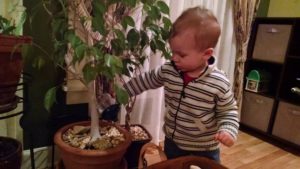
My son watering the Ficus tree with his sippy cup when he was about 18 months old.
I reluctantly had to change my approach to houseplants, especially since becoming a mom back in 2013.
My plant stand with lights made the journey when my husband and I moved into our house. It was filled to capacity in what is now my son’s room until shortly before he was born. I hauled the plant stand and its occupants to work in what I now know was a bad case of nesting.
I filled a lot of my office space with plants, rationalizing that a horticulture educator should have plants in her office. In trying to keep all the proverbial plates spinning in life with a new baby at home, my plants suffered. Many died. I gave up on some of my favorites (such as orchids) after I sadly admitted defeat. I felt like I had no hope of keeping plants alive whether at home or my office.
My “new mom” chapter of life didn’t seem to have room for plants, indoors or out. This was such a hard pill for me to swallow. I’d loved plants and gardening for as long as I could remember. Putting this love aside, even if for only this “chapter” made me so angry. And it made me feel like an imposter, since I was supposed to be teaching horticulture.
I accidentally found the book Indestructible Houseplants by Tovah Martin while researching a houseplant program for work. While I didn’t agree with every plant on her list, her book was inspiring. I thought maybe, just maybe with a few wise choices I could strategically have a menagerie of plants again.
Only my hardiest plants survived my first year of motherhood– in spite of me, not because of me. I started thinking maybe Tovah Martin was really onto something. The plants still alive at my home and office were the “right plant for the right place” — just like what I taught homeowners about choosing plants for their outdoor landscapes in my job as a horticulture educator.
The so-called “indestructible” houseplants can survive a relatively wide range of indoor conditions, and may be just the thing to turn a brown thumb green or keep your love of gardening alive no matter what life chapter you’re in. My list is always evolving, but here are a few of my current favorites:
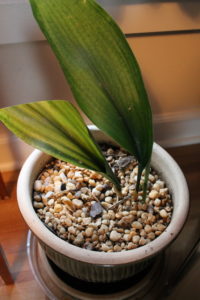
Cast Iron Plant
Cast Iron Plant (Aspidistra elatior)
• Introduced to the U.S. over 100 years ago; can survive outdoors in as cold as Zone 7b.
• Dark green leathery, wrinkled leaves that resemble corn leaves; variegated cultivars ‘Variegata’, ‘Minor’, ‘Milky Way’ and ‘Asahi’ have white stripes or spots.
• My plant sat outside on a north-facing porch from April to October the year my son was born; I barely watered it during that time. When I brought my plants in that fall, my cast iron plant was nothing but shriveled brown leaves. I watered it well and sat it in a corner. Within about six weeks I had a single green leaf. The plant is still growing today, despite my less than attentive care after baby number two in 2016.
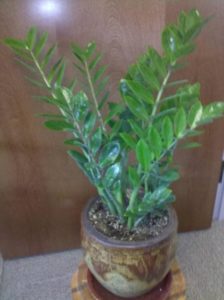
ZZ Plant
ZZ Plant (Zamioculcas zamiifolia)
• Native to East Africa, adapted to extreme drought.
• Prefers bright indirect light; tolerates low light levels. I read a blog entry years ago where the author was trying to deliberately mistreat this plant– he put his ZZ plant in a dark closet for two weeks and it came out looking the same as when he put it in!
• Difficulty propagating and slow growth makes this plant more expensive than most houseplants; I put off buying a plant because I naively thought I could grow my own. The plant grows from a potato-like rhizome; I dug a small one from a friend’s plant but it didn’t survive. I researched growing plants from leaf cuttings, and learned it could take up to 18 months for even a small plantlet to form. That knowledge pretty much sent me straight to the store where I bought the plant pictured. It spent eight years in my office looking great and growing so big I had no room for it in my house and had to leave it behind when I left my Extension job.
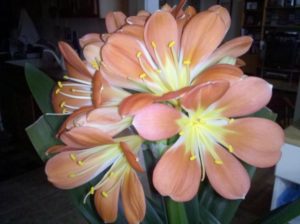
Clivia
Clivia (Clivia miniata)
• Blooms in February or March if given a cool, dry (no watering!) rest period for 12-14 weeks beginning in October or November. A cool room with a bright window the perfect winter residence for Clivia. This is about as close to “no maintenance” you will find in the plant world without resorting to fake plants.
• Needs bright indirect light indoors, and a shaded spot outdoors for the summer.
• Plants will develop root rot if kept too moist.
Pothos or Devil’s Ivy (Epipremnum aureum)
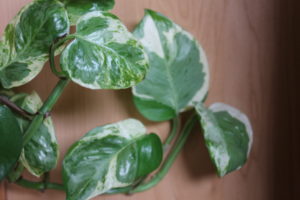
Pothos ‘Pearls and Jade’
• Native to the Solomon Islands; tolerates wide range of light levels; low light causes leaves to lose their multi-color variegation.
• Extremely “brown thumb” resistant—tolerates a lot of neglect and poor cultural practices.
• Easy to propagate—cuttings root easily in water. This is the plant I remember my mom and lots of my relatives usually had in the kitchen, rooting in a jar of water.

Vining Philodendron ‘Lemon Lime’
Philodendron
• Native to South American rain forests; different species grow as a vine, tree, or shrub.
• Very tolerant of low light, but not low temperatures. Low temperatures encourage root rot.
• Water only just before the soil is completely dry in winter. Philodendron are very forgiving, but letting it get too dry for too long is a recipe for death. I figured out the hard way that 12 weeks without water while I was out on maternity leave was too much for my ‘Orange Prince’ Philodendron . It had been a gorgeous plant. Its new leaves were bright orange, and it was planted in a bright blue pot– very much an “Illini” plant. I went to water it and after I removed all the dead leaves there was literally nothing left!
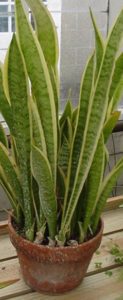
Sansevieria trifasciata
Mother-in-law’s Tongue or Snake Plant (Sansevieria trifasciata)
•Native to Africa, cream to yellow variegations reminiscent of a snake; species Sansevieria cylindrica and dwarf cultivar ‘Fernwood’ have long cylinder shaped leaves.
•Will survive very low light conditions but tends to get elongated and floppy. These plants are extremely “brown thumb resistant”– I’ve seen many dead-looking plants miraculously revive when given just a little TLC. My mom had a plant that even survived the dog dragging it out of the pot and chewing it!
•Repotting is seldom necessary since roots are sparse and plant looks best when allowed to crowd the pot; also may produce flowers when root bound.
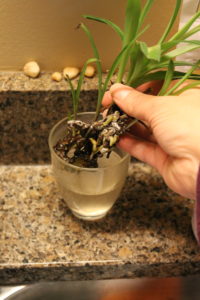
Piece of overgrown, neglected Spider plant rooting in water.
Spider Plant (Chlorophytum comosum)
•Native to South Africa, common name comes from long, thin leaves emerging from a central point, plus “babies” borne on long stems.
•Prefers cool to average home temperatures, but will tolerate warmer temperatures. Thick fleshy roots store water, making it very tolerant of inconsistent watering. I recently took an overgrown, half dead stem from a plant I’ve had for over thirty years and put it in water– and roots started growing!
•Fluoride in tap water will turn leaf tips brown. Use distilled or rainwater to prevent tip browning. Or just cut the leaf tips periodically with scissors.
•Spider plant “babies” are easily propagated just by planting in their own pot. There’s nothing wrong with using these “babies” in your container gardens outdoors this spring. They add some variety to your annuals, and the price is right!
Wax Plant (Hoya sp.)
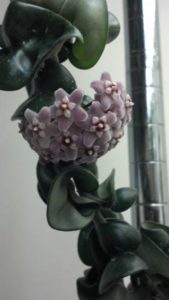
My Hoya ‘Hindu Rope’ in bloom
•Succulent hairy or shiny leaves
•Allow soil to dry completely between watering.
•Tolerates low light; bright indirect light needed for flowering
•Encourage blooming by allowing plant to become root bound
•Spindly-looking growth in early spring is likely the start of flowering—don’t remove this growth! I couldn’t figure out why my Hoya never bloomed until I realized what I thought was leggy winter growth was the start of flowering. Once I stopped interfering my plant produced the blooms pictured.
•Do not deadhead as flowers develop in the same spot each year
•Flowers may be hairy or shiny; borne in clusters; some find their scent overwhelming indoors. When my Hoya bloomed, the flowers smelled like chocolate, so there was no issue with being overwhelmed!
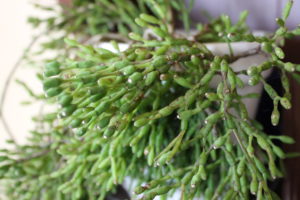
Dancing Bones Cactus (Hatiora salicornioides or Rhipsalis salicornioides)
Cacti and Succulents
•Enormous variety of shapes, sizes, colors– great for satisfying your inner plant hoarder collector
•Need bright light for healthy growth–experiment with your available space. I was shocked to find my east-facing bathroom window was bright enough, even in winter, to successfully host succulents.
•Easily propagated by cuttings; remember to let cut ends dry for a few days before placing them in soil otherwise they’re likely to rot.
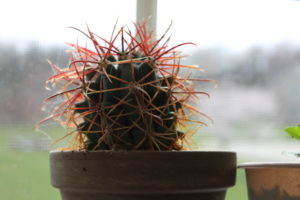
25 year old cactus I started from seed as a high school student back in 1992.
•Cacti and succulents are a perfect match for forgetful waterers– watering every month to six weeks during the winter works well for me, more often during the summer, especially if my plants are outside. A significant chunk of my current houseplant population is a cactus or a succulent. This is not a coincidence! They are so forgiving of sporadic watering, and in fact that may be why they are doing so well under my care. Cacti and succulents tend to develop root rot if they are watered too often, particularly in winter. Not a problem at my house!
Taming Your Inner Plant Hoarder
It was reassuring when I figured out some plants that could survive and thrive even in my crazy-busy new mom life. Somehow it kept me from being swallowed whole by my new identity: MOM. But finding balance has always been tricky for me. I want to do everything, to say yes to everyone, to take home all the plants that catch my eye. But even the things we love can drag us down and become a chore. I was learning this lesson with my garden outside. It was time to learn it inside too.
I’ve had some success taming my other sprawling interests– knitting and spinning, by designating space they can fill. As in, my yarn/fiber stash may fill ‘x’ number of plastic totes, but no more. I started to do the same thing with my plants.

Assorted succulents in my east-facing bathroom window
My brightest windows became the limits for my plant collections. I no longer had the space, and honestly no time for a room full of plants under lights like years ago.
Of course I did maximize the available space at the windows. I found these clear plastic shelves that attach via suction cups pictured here. I installed them on east, south and west facing windows where they stayed put all winter– not a single one of them fell down.
Am I still a plant hoarder? Left unchecked to my own devices, probably. There’s always my tendency to find room for “just one more”. But I am finding joy in my smaller collection that is way more forgiving when life gets busy and doesn’t stress me out trying to carve out time to care for it.
Finding space for plants in this busy chapter of life has been challenging. It’s not the space on my windowsill– more like the space to let my own interests still exist despite new identities and responsibilities. Simplifying my approach with less plants, but better plant choices has been key.
If you liked this post, please subscribe to Grounded and Growing today and receive your copy of “15 Tips to Become a '15 Minute Gardener'” so you can spend less time working ON your garden and more time enjoying being IN your garden.! It’s absolutely free. When you join the Grounded and Growing community, you’ll finally take the garden off your “To-Do” list and allow yourself time to enjoy your garden and savor the peace and serenity there. I tell subscribers about new posts as soon as I hit ‘publish’ and send weekly-ish updates on what’s going on in my garden– good, bad AND ugly.
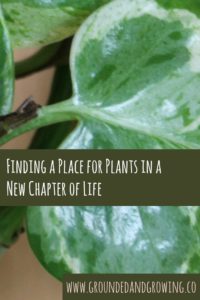
Leave a Reply